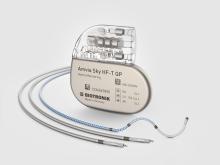BIOTRONIK, a global leader in cardiovascular, endovascular, and neuromodulation solutions, today announces the launch of BIOMAG-LL, a pre-market trial focused on confirming the safety and clinical performance of Freesolve® Resorbable Magnesium Scaffold (RMS), for the treatment of long de novo lesions in native coronary arteries.The BIOMAG-LL is a prospective, international, multi-center, single arm pre-market study that will enroll 100 patients in Europe with de novo coronary artery stenosis and long lesions. Given that the Freesolve RMS is already CE-certified for shorter lesions, the BIOMAG-LL study will evaluate its effectiveness in longer lesions with new device sizes including now 35 mm and 40 mm scaffold lengths to support a broader market release. "We are pleased to introduce the BIOMAG-LL trial as a pre-market study with a particular focus on treating longer coronary lesions," says Prof. Flavio Ribichini, Interventional Cardiologist and Director of the Division of Cardiology at the Universi
BIOTRONIK today announces the launch of the latest innovations in guide extension catheters: FlowGuide and Guidion Short. These new devices have been developed to offer enhanced support and to facilitate the delivery of devices during complex vascular interventions. The catheters introduce key elements, such as perfusion holes in the distal shaft of the FlowGuide catheter, and a transradial access and trapping friendly design for both new products. Through our collaboration with IMDS, the FlowGuide and Guidion Short catheters expand BIOTRONIK's portfolio of high-performance devices dedicated to complex PCI (percutaneous coronary intervention) such as the TrapIT, NHancer Rx, and ReCross. Developed and manufactured by IMDS (Interventional Medical Device Solutions), they are distributed by BIOTRONIK in selected countries. The nine circumferential perfusion holes* in the distal shaft of the FlowGuide catheter are designed to maintain optimal blood flow to distal vessels and side branches1, thereby reducing t
BIOTRONIK announced today the enrollment of the first patient in the BIOMAG-II trial aiming to evaluate the safety and clinical performance of its new-generation resorbable magnesium scaffold (RMS), Freesolve™, compared to a contemporary drug-eluting stent (DES). "We are delighted to enroll the first patient in the BIOMAG-II trial, which may play a critical role in helping establish resorbable metallic scaffolds as part of clinical practice in the future and I am particularly encouraged by the implantation results of the Freesolve resorbable magnesium scaffold," said Dr. Juan F. Iglesias, HUG - University Hospital Geneva in Switzerland. "Resorbable scaffolds have shown potential in reducing long-term adverse events compared to DES, marking a significant advancement in vascular intervention. We finally have a scaffold that delivers on its promise." The BIOMAG-II trial is a prospective, international multi-center randomized-controlled study spanning 21 countries across Europe and the Asia-Pacific region
Find useful downloadable assets and press kits
Results from the MATRIX study show that the high detection accuracy of DX single-lead ICD systems for atrial fibrillation (AF) episodes (99.7% for ≥ 1h episodes) in combination with the strong transmission performance of BIOTRONIK Home Monitoring® allows for reliable guideline-recommended remote monitoring of subclinical AF. The findings were published in Europace earlier this week.1MATRIX evaluated the utility of the DX-ICD system (atrial signal detection via a floating dipole integrated in the ICD lead) for remotely monitoring atrial high-rate episodes (AHRE) and their duration progression. In addition, the study analyzed the clinical implications of AHRE detection and progression. The outcome of the study should be interpreted in the context of the 2020 European Society of Cardiology’s guidelines on AF which recommend remote monitoring of device-detected AHRE and provide further guidance depending on the AF burden along pre-specified duration strata.The study was led by Prof. Dr. Gerhard Hindricks, De
Prof. Michael Haude, BIOMAG-I Coordinating Clinical Investigator, presented the latest results of the BIOMAG-I clinical study at the Cardiovascular Research Technologies (CRT) meeting.1 At six months the angiographic and clinical data showed a low in-scaffold late lumen loss (LLL) rate and a good safety profile with no scaffold thrombosis. A low proportion of mal-apposed struts after implantation was observed, at six months struts were no longer discernable. The intravascular imaging documented a preservation of the scaffold area with a low mean neointimal area. Bioresorbable scaffolds have been developed to provide temporary mechanical support, while controlling neointimal proliferation over the vascular healing period and preventing long-term stent-related adverse events. DREAMS 3G, BIOTRONIK’s next generation drug-eluting resorbable Magnesium scaffold (RMS), is made of a proprietary Magnesium alloy and maintains a resorption time of 12 months. Compared to its predecessor DREAMS 2G, it offers unique be
In the first-in-human study BIOMAG-I, BIOTRONIK’s new-generation DREAMS 3G resorbable magnesium scaffold (RMS) showed significantly lower in-scaffold late lumen loss (LLL) than its predecessor at 12 months as well as excellent safety and efficacy. Prof. Michael Haude, BIOMAG-I Coordinating Clinical Investigator, presented the latest results in the late breaking trial session at the EuroPCR course.1 At one-year follow-up, BIOMAG-I data confirmed the excellent safety profile of DREAMS 3G RMS with a low target lesion failure rate of 2.6%. Neither cardiac death and myocardial infarction occurred, nor scaffold thrombosis was reported. After completion of the resorption, the in-scaffold LLL was 0.24±0.36 mm, comparable to contemporary drug-eluting stents (DES).2 “At the end of the scaffold resorption, at 12 months the data showed, that the DREAMS 3G scaffold has an excellent safety and efficacy profile”, said Prof Michael Haude, Rheinland Klinikum, Germany. “The late lumen loss is not just 38% better
